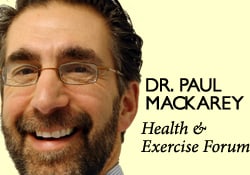
It is a well established fact in the medical literature that the benefits of regular exercise and physical activity are numerous, from reducing blood pressure to lowering the risk of falls. However, a study recently conducted in the Human Performance Lab at Ball State University and published in The Journal of Applied Physiology found that people in their 70s who have been exercising regularly for decades have defied the aging process…maintaining heart, lung and muscle fitness of healthy people at least 30 years younger!
As it turns out, many people who began exercising in the 1970’s running and aerobic boom have continued to do so for 50 years without interruption. Researches felt that this population of lifetime fitness enthusiasts would be interesting to study and compare to their contemporaries and younger people.
Subjects were divided into three groups; Group One: Lifelong Aerobic Exercisers with an average age of 75 years, who engaged in a structured aerobic program of running or cycling, four to six days a week, seven hours per week. Group Two: No Structured Exercise throughout life, with an average age of 75 years, who may have occasionally walked, golfed or participated in leisure activities. Group Three: Lifelong Aerobic Exercisers with an average age of 25 years, who, like their senior counterparts, engaged in a structured aerobic program of running or cycling, four to six days a week, seven hours per week.
All subjects were assessed for cardiovascular fitness on an indoor bike to determine maximum oxygen uptake (VO2 Max). Muscle biopsies were also performed to assess microcirculation to the muscle and blood work was conducted to examine enzyme levels related to carbohydrate and fat metabolism.
Results showed that those engaging in aerobic exercise consistently throughout their lives had both muscle and cardiovascular benefits similar to those 30 years younger.
It is important to note that in this study an aerobic program consisted of running or cycling, four to six days a week, seven hours per week. This level of lifelong commitment is limited to a very select group of individuals. However, many other studies have demonstrated the value of any aerobic exercise program, even if less intense.
In general terms, aerobic exercise is any type of sustained exercise that strengthens the heart and lungs to improve the body’s use of oxygen. This may include running/jogging, brisk walking, cycling, swimming, rowing, and the use of a treadmill, elliptical, stepper or similar device, at light to moderate intensity which requires the use of oxygen to adequately meet the oxygen demands of the body for an extended period of time. The generally accepted time and frequency is at least 30 minute sessions performed three or more times per week.
Moreover, it is important to remember that everyone ages differently. With the onset of age related osteoarthritis and other illnesses, one may not be capable of maintaining regular exercise with the intensity described in this study. Regular exercise, even at a low to moderate level has many benefits. In fact, studies continue to support the fact that a well-balanced and individualized exercise program including aerobic, strengthening, stretching and balance activities contribute to, not only longevity, but quality of life.
Visit your doctor regularly and listen to your body.
Keep moving, eat healthy foods, exercise regularly, and live long and well!
NEXT MONDAY – Read Dr. Paul J. Mackarey “Health & Exercise Forum!”
This article is not intended as a substitute for medical treatment. If you have questions related to your medical condition, please contact your family physician. For further inquires related to this topic email: drpmackarey@msn.com
Paul J. Mackarey PT, DHSc, OCS is a Doctor in Health Sciences specializing in orthopaedic and sports physical therapy. Dr. Mackarey is in private practice and is an associate professor of clinical medicine at GCSOM.